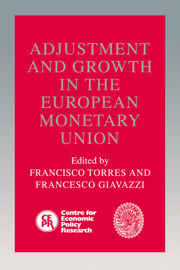Book contents
- Frontmatter
- Contents
- List of figures
- List of tables
- Preface
- List of contributors
- Foreword
- 1 Introduction
- 2 Economic and monetary union: critical notes on the Maastricht Treaty revisions
- Discussion
- 3 The design of optimal fiscal rules for Europe after 1992
- Discussion
- 4 Contracts, credibility and common knowledge: their influence on inflation convergence
- Discussion
- 5 Inflation in fixed exchange regimes: the recent Portuguese experience
- Discussion
- 6 Models of economic integration and localized growth
- Discussion
- 7 Shocking aspects of European monetary integration
- Discussion
- 8 Lessons of Massachusetts for EMU
- Discussion
- 9 Financial and currency integration in the European monetary system: the statistical record
- Discussion
- 10 Currency substitution: from the policy questions to the theory and back
- Discussion
- 11 Coordination of capital income taxes in the economic and monetary union: what needs to be done?
- Discussion
- Index
2 - Economic and monetary union: critical notes on the Maastricht Treaty revisions
Published online by Cambridge University Press: 29 January 2010
- Frontmatter
- Contents
- List of figures
- List of tables
- Preface
- List of contributors
- Foreword
- 1 Introduction
- 2 Economic and monetary union: critical notes on the Maastricht Treaty revisions
- Discussion
- 3 The design of optimal fiscal rules for Europe after 1992
- Discussion
- 4 Contracts, credibility and common knowledge: their influence on inflation convergence
- Discussion
- 5 Inflation in fixed exchange regimes: the recent Portuguese experience
- Discussion
- 6 Models of economic integration and localized growth
- Discussion
- 7 Shocking aspects of European monetary integration
- Discussion
- 8 Lessons of Massachusetts for EMU
- Discussion
- 9 Financial and currency integration in the European monetary system: the statistical record
- Discussion
- 10 Currency substitution: from the policy questions to the theory and back
- Discussion
- 11 Coordination of capital income taxes in the economic and monetary union: what needs to be done?
- Discussion
- Index
Summary
Introduction
The inter-governmental conference (IGC) on economic and monetary union (EMU) which started in Rome in December 1990 and was concluded in Maastricht one year later had two main tasks. The first was to define, as precisely as possible, how collective authority over economic policy will be exercised in the final stage of EMU. This entailed setting out the legal and institutional framework for full monetary union and taking the necessary steps for the implementation of the non-monetary policies which will accompany the irrevocable locking of parities among the participating currencies and the subsequent introduction of a single currency. Preparations for the IGC, notably the draft statute proposed by the committee of EC central bank governors in November 1990, and early work in the IGC on EMU focused on this task. The institutional design which has emerged is the main achievement of the past year's negotiations. It has revealed a degree of support, which could not have been expected when the EMU debate started, among the policy-makers in the Community for entrusting joint monetary policy to a central banking institution which is (i) committed to the primary objective of price stability, and (ii) remarkably independent, through a number of safeguards, from short-term political pressures.
- Type
- Chapter
- Information
- Adjustment and Growth in the European Monetary Union , pp. 9 - 41Publisher: Cambridge University PressPrint publication year: 1993
- 1
- Cited by

